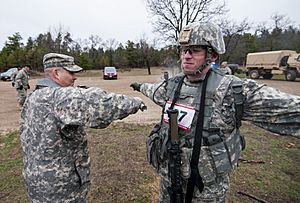Insecticide facts for kids
An insecticide is a special type of pesticide that is used to kill insects or stop them from growing and multiplying.
Insecticides are used a lot in agriculture (farming) to protect crops. They are also used in homes and workplaces to control pests. Using insecticides has helped farmers grow much more food, especially since the 1900s.
Contents
What Are the Different Types of Insecticides?
Over time, many different kinds of insecticides have been created. Newer types often replace older ones.
For a long time, people used things like lead, mercury, and arsenic to kill insects. They also used natural poisons from plants, like nicotine from tobacco and substances from the pyrethrum flower.
Later, scientists developed new chemicals. The goal was to make insecticides that were safer for people and the environment.
How Do Insecticides Affect the Environment?
When new insecticides are made, scientists try to make them less harmful. For example, a chemical called DDT was once thought to be safer than older ones like lead and arsenic.
However, even "safe" chemicals can cause problems if they are not used correctly. They can harm life and the environment.
Some insecticides, like DDT, were later banned in many places. This happened because they stayed in the environment for a long time and harmed animals and humans. For instance, DDT made the eggshells of large birds, like the peregrine falcon, very thin. This meant the eggs often broke, and bird populations went down.
After DDT was banned for farming, some bird populations started to recover.
Sometimes, insects become resistant to an insecticide. This means the insecticide no longer works on them. When this happens, new chemicals like Lindane have to be used instead.
Some strong insecticides, like Dieldrin, can be useful for specific jobs, like stopping termites from eating telephone cables. But they must be used very carefully and are not safe for spraying near places like school playgrounds.
How Are Insecticides Used?
You might use a personal insecticide, often called "bug spray." It usually comes in a plastic bottle or an aerosol can. You spray it on your clothes, arms, and legs. This helps to keep bugs away or kills them if they land on you.
Insecticides used to kill pests like insects and arachnids (spiders) often come in aerosol cans. You might spray them into the air or directly onto a nest. These sprays can kill house flies, blowflies, ants, cockroaches, and spiders.
Many bug sprays contain active ingredients like permethrin and tetramethrin. These chemicals affect the nervous system of insects and spiders, which helps to kill them.
It's important to use bug spray in places with good airflow, like outdoors or in a well-ventilated room. The chemicals in these sprays can be harmful to humans if you breathe in too much.
Images for kids
-
Farmer spraying an insecticide on a cashewnut tree in Tanzania
See also
 In Spanish: Insecticida para niños
In Spanish: Insecticida para niños






